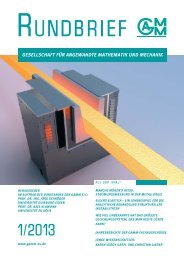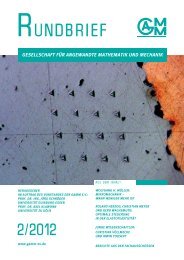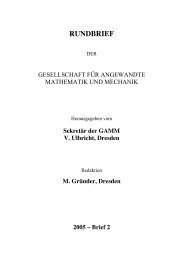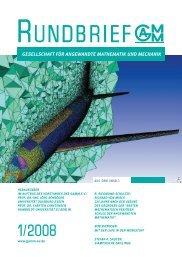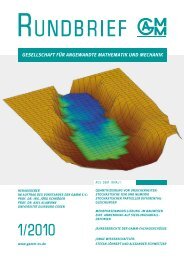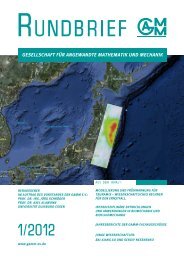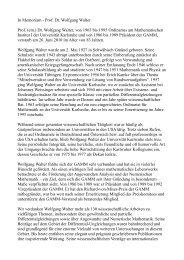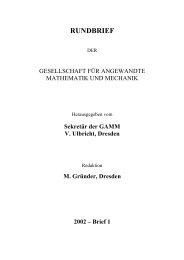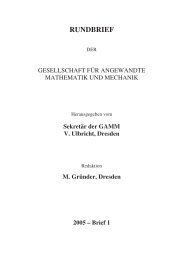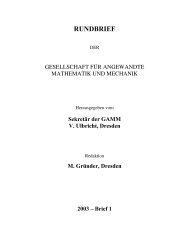GAMM Rundbrief 2002/Heft 2
GAMM Rundbrief 2002/Heft 2
GAMM Rundbrief 2002/Heft 2
Create successful ePaper yourself
Turn your PDF publications into a flip-book with our unique Google optimized e-Paper software.
104<br />
Neue Bücher und Zeitschriften<br />
Associate editors<br />
D. J. Murray-Smith (Glasgow (UK) R. Skelton (San Diego, USA)<br />
P. C. Müller (Wuppertal, BRD G. Zobrist (Missouri-Rolla, USA))<br />
S. Marsili-Libelli (Firenze, Italy)<br />
Editorial board N. A. Kheir (USA)<br />
P. C. Breedveld (Enschede, NL) H. Kwakernaak (Enschede, Netherlands)<br />
F. Breitenecker (Wien, Austria) L. Ljung (Lund, Sweden)<br />
F. Cellier (Tucson, USA) C. Maffezoni (Milan, Italy)<br />
F. L. Chernousko ( Moscow, Russia) J. McPhee (Waterloo, Canada)<br />
A. Cheruy (Grenoble, F) J. V. R. Prasad (Atlanta, USA)<br />
S. Engell (Dortmund, BRD) W. Schiehlen (Stuttgart, BRD)<br />
B. A. Foss (Trondheim, Norway) K. Schlacher (Linz, A)<br />
K. Furuta (Tokyo, Japan) S. Tzafestas (Athens, Greece)<br />
R. Hanus (Bruxelles, B) R. Viertl (Wien, Austria)<br />
R. Karba (Ljubliana, Slovenia) M. Zeitz (Stuttgart, BRD)<br />
D. Karnopp (Davis, USA)<br />
Scope<br />
The analysis and improvement of performance in complex systems, the adaptation of plants to<br />
new demands or conditions and the design of 'optimal' systems are a few of the challenges<br />
confronting engineers and systems scientists today. In many cases solutions to problems in<br />
areas such as these may be found through the use of appropriate mathematical models. The<br />
dynamic case, whether continuous time or discrete time, deterministic or stochastic, presents<br />
special challenges and derivation of an appropriate solution depends strongly on the proper<br />
initial formulation of the goals and constraints. Increasingly this demands an interdisciplinary<br />
approach to modelling.<br />
Models of the kind discussed above can take the form of sets of equations, graphs or nets, or<br />
some combination of elements such as these. The derivation, combination, simplification and<br />
validation of models and sub-models are the main topics of this journal which provides an<br />
international forum for the presentation of new ideas in modelling and for the exchange of<br />
experience and knowledge through descriptions of specific applications. Original work will be<br />
published as regular papers or short notes dealing with a range of topics including the<br />
following:<br />
- processes and methods for model formulation, identification,<br />
- development, reduction and validation etc. (including guidelines and check lists),<br />
- automation of modelling and software aids for modelling,<br />
- the relationship between computational/simulation methods, the underlying mathematical<br />
formulation and real-world modelling problems,<br />
- qualitative modelling and fuzzy approaches to modelling,<br />
- modular modelling (especially applied to interdisciplinary fields such as mechatronic or<br />
controlled environmental systems),<br />
- learning networks in modelling,<br />
- uncertainties in modelling,<br />
- the relationship between the modelling approach and problem solutions,<br />
- comparisons of methods for modelling, model reduction and model validation,<br />
- effects of modelling errors on overall performance of an engineering system (e.g.<br />
relationship between modelling and control design),<br />
- applications in the field of engineering systems,



